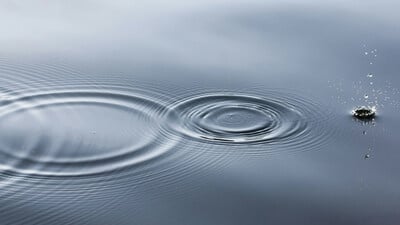What is rainwater harvesting?
If you use a water butt to collect rain for watering your plants, you are already harvesting rainwater, although at its most basic level. Proper rainwater harvesting takes this concept to a larger scale and a new level, capturing this valuable resource to save on water around the home, business, horticultural nursery or farm.
Rainwater harvesting can also be used to collect rainwater from other large, non-porous areas such as patios, driveways and similar, although bear in mind that areas used by vehicles are likely to be more contaminated and therefore will limit the usefulness of the harvested water.
Rainwater harvesting tanks are considerably larger than water butts and can be located above or below ground. They are also fitted with a pump to feed the water into a header tank (for domestic and commercial use) or to livestock watering, washdown and plant irrigation systems.
Although rainwater is reasonably clean, it collects dust, dirt, leaves and moss from roofs and gutters; these contaminate the water and promote bacterial growth. Rainwater harvesting systems that are fitted with standard filters remove most of this debris from the water, while more advanced filters and UV light sterilisers can further improve the quality.
Why is rainwater harvesting important?
There are three reasons why rainwater harvesting is increasing in popularity: adapting to a changeable climate, reducing the demand on water supplies and cutting water bills.
Adapting to climate
Although we are seeing warm, dry summers more frequently, in the UK we still have a reasonable amount of rain during the year. By saving it up during the wet seasons, we can fall back on this supply when there is little or no rain and mains water supplies must be conserved, using it to water gardens and wash cars at home, provide drinking water for livestock and irrigate plants.
Rain that falls on roofs and other non-porous surfaces normally flows into drains, but as the percentage of porous land – particularly in urban areas – decreases, stormwater drainage systems and watercourses are less able to contain the level of runoff during periods of high rainfall and this causes problems such as flooding. Rainwater harvesting can help to mitigate this problem.
Harvested rainwater also benefits the environment by reducing the amount of energy consumed to unnecessarily treat mains water that doesn’t need treating, and to pump this back to your house.
For some applications, filtered rainwater is even better than tap water. It is naturally soft, making it ideal for conditioner-free laundry, and as it contains none of the chemicals such as fluoride and chlorine that are in tap water, it’s better for your garden. If you invest in more advanced filtration so you can use it for showers and baths, you will also notice you need to use less bath or shower lotion, shampoo and conditioner.
Meeting demand with supply
As the UK population continues to grow, greater demand is placed on utility companies to ensure an adequate water supply, particularly during the warmer months when reservoir levels fall and the population cools off in pools and showers.
Harvested rainwater is a resource that literally goes down the drain if we don’t save it, but can make a meaningful difference to our reliance on mains water and reduce the chances of water restrictions being implemented.
Reducing the cost of water
While a rainwater harvesting system requires an initial investment, this can quickly be repaid by using it to substitute for mains water. And this isn’t limited to watering the garden and washing the car.
In the home, filtered rainwater can be used to flush toilets and wash clothes. With additional filtration, it can also be used for showers, baths and dishwashers, while filters that can remove particles as small as 5 microns and UV sterilisation can potentially render it safe for cooking and drinking. Even if you only use it for flushing toilets and washing clothes, the UK Rainwater Management Association estimates you can cut mains water consumption by up to 50%.
Commercially, it can be used for toilet flushing in hotels, sports or leisure centres and any similar large venue. Industries that use large amounts of non-potable water for cleaning and cooling can also benefit from rainwater harvesting, particularly as they often have roofs with large surface areas and great harvesting potential.
Agriculture and horticulture have been leading the market in rainwater harvesting, and the UK Government is even offering a grant scheme to assist farmers with the cost of installing rainwater harvesting systems.
Rainwater harvesting tanks: above or below ground?
Above-ground rainwater harvesting tanks
Above-ground tanks are mostly popular in commercial, industrial and agricultural applications, where the presence of a large plastic tank doesn’t spoil the view.
Costing less to purchase than below-ground tanks, they are also easier, faster and cheaper to install as they don’t require excavation; just a flat, firm surface to stand on. Their accessibility also facilitates maintenance and makes damage easier to detect and repair.
If you have enough space to put an above-ground rainwater harvesting tank in your garden – using a fence, wall or hedge to screen it from view – you will be able to water your plants and lawn using gravity rather than installing a pump.
On the downside, water stored in an above-ground tank is more prone to freezing in cold weather and overheating in the summer. While insulation can protect against temperature extremes, potentially harmful levels of bacteria such as Legionella can grow in warm, standing water and regular cleaning will be required to prevent this.
Below-ground rainwater harvesting tanks
As we have already mentioned, the initial investment involved in buying and installing a below-ground rainwater harvesting tank is higher than that of an above-ground tank. You will need to excavate a large hole to contain the tank, reinforced to protect the tank against ground pressure. Not all soil types are compatible with below-ground water storage tanks.
Unless it is properly installed, a below-ground tank could be damaged by shifting or settling soil. If this happens, leaks may be hard to detect and harder still to repair.
However, this option brings many benefits.
Once a below-ground tank has been installed, it is out of the way and out of sight. It doesn’t take up valuable space and won’t detract from the beauty of the garden.
Combined with the benefit of having an additional supply of free water, a properly installed below-ground tank that is fully integrated within your home’s water system can only increase the property value of your home.
Placing the tank below-ground level will also help it maintain a more constant water temperature; no winter freezing or summer Legionella to worry about. Being plastic, the tank will also last for longer if it isn’t exposed to damaging UV radiation in sunlight.
If you are using your harvested rainwater in the home (which is the best way of recouping your investment), you will need to fit an electric pump anyway, even to an above-ground tank.
How much money could rainwater harvesting save me?
Once you’ve calculated the cost of purchasing and installing a rainwater harvesting system (budget for around £2000-3000 plus installation), it’s time to work out how much you can save on water bills. After all, this is how you’re going to repay that investment.
On average, 25-30% of a household’s water consumption goes to flushing toilets, so as a conservative estimate you can slash your water bills by a quarter.
A washing machine also accounts for 15-20% of your water usage, so add that to the above and you’ve now chopped 40% off your water bills. It could be even as high as 50%.
Running the system and pump should cost no more than 10p a week in electricity; a minimal expense that you hardly need to factor into your calculations.
Is rainwater harvesting right for me?
That’s a decision you will need to make, based on your specific circumstances, property, budget and long-term plans, but we hope this article has helped set you on the right road to making a decision.
If you have any further questions you are always welcome to call our friendly team of experts on 01420 555600 or email [email protected].
Also, look out for more articles in our ongoing series of blog posts, bringing you useful information, insights, guides and tips on all things drainage!

Written by
Bob Stone
Technical Sales
Heading up our Technical Estimating Department, Bob is our in-house quantity surveyor.

